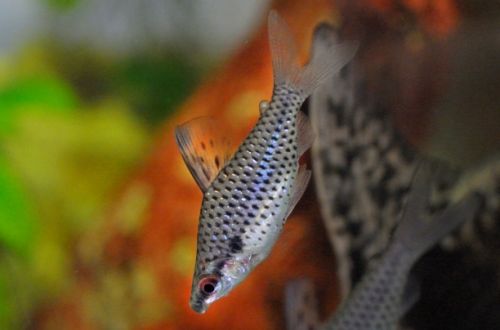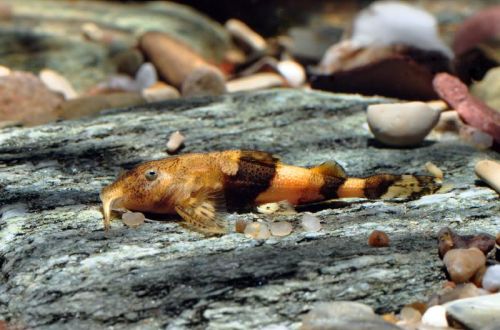
Hylodus
Chilodus, scientific name Chilodus punctatus, belongs to the Chilodontidae family. From common English names, this species is translated as “standing on its head” due to the unique way of movement. He spends most of his time with his tail up above his head, thus holding his body not horizontally, but at an angle.

Difficult enough to keep and breed in a home aquarium, and almost beyond the power of novice aquarists. Requires high quality water of a certain composition, but if you can solve this problem, then a flock of Chilodus will become a real sparkling treasure in your aquarium.
Habitat
It is widely distributed in the upper reaches of the Amazon Basin (South America) in the territory of modern Ecuador, Peru and Brazil, as well as in the Orinoco river system in Colombia. It lives in low-speed streams and rivers, tributaries, floodplain lakes, flooded forest areas.
Lýsing
Slender graceful fish, the back has a pronounced rise, crowned with a dorsal fin. The tail is distinctly divided into two parts – the petal. The color is silvery with numerous dark specks, in the center they are located most densely, thereby forming a horizontal line. The specks continue on the fins, which are generally transparent, but sometimes have a reddish tint. Sex differences are weakly expressed. In males, the dorsal fin is somewhat higher than in females, which in turn have a more rounded shape.
Matur
The diet should consist of a variety of products that combine meat and vegetable components. Bloodworm, daphnia, brine shrimp with additions of pyrulina flakes, small pieces of cucumbers, lettuce, some fruits typical of the upper Amazon.
Only experienced aquarists are allowed to experiment with the diet, for the rest it is more expedient to purchase specialized high-quality food from well-known manufacturers.
Viðhald og umhirða
A flock of fish needs a spacious tank, for 10 individuals at least 200 liters. In the design, it is necessary to achieve a balance between free areas and dense thickets of plants in a ratio of 50 to 50. Floating plants are welcome, they are assigned the role of shading part of the aquarium. The substrate is sandy, on which there are various shelters made of snags, branches and/or tree roots. Several dried leaves can be lowered to the bottom; in the process of decomposition, they saturate the water with tannins and lightly color it, which is typical of the natural habitat of Chilodus. Leaves should be updated weekly.
Water to fill the aquarium should have the following parameters – soft and slightly acidic, this is the responsibility of dGH and pH. More details about the parameters of water and ways to change them are described in detail in the section “Hydrochemical composition of water”.
The minimum set of equipment consists of an aerator, a heater, lighting and a filtration system. The latter are more demanding. It is advisable to purchase the most productive filter available to you in finance. Peat-based fillers can be used as a filter material; in addition to cleaning, they are able to acidify water.
Hegðun
A peaceful and somewhat shy fish, it needs calm, not noisy neighbors. Together with Chilodus, you can keep some South American cichlids, Corydoras catfish and other peaceful representatives of the Amazon. Prefers to stay in a flock of at least 10 individuals, with a smaller number in the presence of other fish, may suffer from excessive stress.
Ræktun / ræktun
A very troublesome process for most aquarists who enjoy watching their pets but are not prepared to spend a lot of time and resources on breeding. Before spawning, the largest males and females are deposited in separate tanks, where they live for 2–3 weeks and intensively feed on live food. In this case, dry packaged food is not suitable. Then they are combined in a spawning aquarium, which is a tank with a low water height of up to 20 cm, soft and acidic. Registration is not required, the only point is that it is desirable to place a fine-mesh net on the bottom to protect the caviar from being eaten. The equipment includes a simple sponge filter, an aerator, a low power lighting system and a heater. The temperature is set 2-3 degrees higher than in the general aquarium.
Future parents are placed in a spawning aquarium in the evening so that they sit down to acclimatize overnight. Spawning may start the next day or you may have to wait, in which case don’t forget to feed them. After a fleeting courtship procedure, each female lays up to 300 eggs. Without a protective net, the eggs will be eaten!
Parents are returned to the common aquarium, and the eggs are placed in a three-liter jar. The height of the water is up to 5 cm, and a weak aerator is installed, the temperature is maintained around 28 ° C. The fry appear after 4-5 days, grow unevenly, some will significantly overtake in growth, but no cannibalism was noticed.





